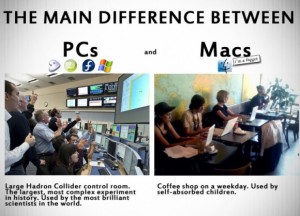From the title my blog, it’s quite obvious that this is the final blog of the course. Throughout the term, I have learned a lot about marketing. Nowadays, I can’t even read ads without applying the concepts I have learned in this class and it has been a pleasure to learn so much.
Recently, I read a blog talking about creative marketing versus ordinary and obvious marketing. This blog was from Influential Marketing Blog and is titled “The Upside of Being Ordinary and Obvious” (http://www.rohitbhargava.com/). According to the blog, sometimes it’s actually more effective being ordinary and obvious. When one is shopping for a necessity, there really is no reason promoting such a product with flashy, creative advertisements when what consumers really need is just the practical use of that product.
 One clear example I can think of is the Mac versus PC. Both have their strengths and their differences appeal to different types of people. In the minds of most consumers, the difference is really just the practical use of each computer. Mac is shown to be more artistic and creative while PC has been used for the most of our lives that there really is not much reason to switch. Many software and tools can only be used on a PC while others are only for Macs. So in the end, there really is no reason to compare which one is better when it just depends on the user.
One clear example I can think of is the Mac versus PC. Both have their strengths and their differences appeal to different types of people. In the minds of most consumers, the difference is really just the practical use of each computer. Mac is shown to be more artistic and creative while PC has been used for the most of our lives that there really is not much reason to switch. Many software and tools can only be used on a PC while others are only for Macs. So in the end, there really is no reason to compare which one is better when it just depends on the user.

As our discussion comes to an end, being an ordinary person and being an extravagant person also has their own advantages. While we were growing up, being ordinary always seemed so “uncool” and only the extravagant people get all the attention. However, as we mature, we realize that being ordinary with a stable life can make us even happier.



